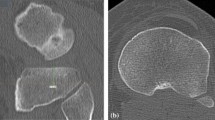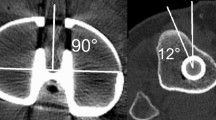Abstract
Purpose
The incidence of anteroposterior overhang of the tibial component after TKA and its effect on clinical outcome were investigated, and the morphometric characteristics of the knees in which tibial baseplates were oversized were identified.
Method
One hundred and fourteen consecutive TKAs were retrospectively assessed. The dimensions of the tibia were measured on a pre-operative CT scan and were compared with those of the implanted tibial component. We analysed the effect of anteroposterior and mediolateral size variations on clinical outcomes 1 year after surgery.
Results
An anteroposterior overhang was observed in 87 % of cases on the lateral plateau, in 88 % on the central plateau and in 25 % on the medial tibial plateau. The mean post–pre-operative size differences were 3.2 ± 2.7, 2.8 ± 2.7 and −1.6 ± 2.3 mm, respectively. (Positive value means oversizing). A mediolateral overhang of the tibial component was found in 61 % of the patients. Oversizing was significantly greater and more frequent in females. Patients oversized in the anteroposterior dimension had lower post-operative pain scores. Patients with mediolateral oversizing had decreased flexion 1 year after surgery. Anteroposterior oversizing was observed more frequently in patients with asymmetric tibial plateaus, while mediolateral oversizing was observed more frequently in patients with small tibias.
Conclusions
This study demonstrates that the incidence of oversized tibial plateau components is surprisingly high and that functional outcomes are lower in the case of mediolateral or anteroposterior oversizing. The risk of oversizing could be predicted as it occurs predominantly in patients with asymmetric proximal tibia and/or small tibia.
Level of evidence
IV.





Similar content being viewed by others
References
Allardyce TJ, Scuderi GR, Insall JN (1997) Arthroscopic treatment of popliteus tendon dysfunction following total knee arthroplasty. J Arthroplasty 12:353–355
Anderson JG, Wixson RL, Tsai D, Stulberg SD, Chang RW (1996) Functional outcome and patient satisfaction in total knee patients over the age of 75. J Arthroplasty 11:831–840
Argenson JN, Scuderi GR, Komistek RD, Scott WN, Kelly MA, Aubaniac JM (2005) In vivo kinematic evaluation and design considerations related to high flexion in total knee arthroplasty. J Biomech 38:277–284
Barnes CL, Scott RD (1995) Popliteus tendon dysfunction following total knee arthroplasty. J Arthroplasty 10:543–545
Barrett WP (2006) The need for gender-specific prostheses in TKA: does size make a difference? Orthopedics 29:S53–S55
Bartel DL, Bicknell VL, Wright TM (1986) The effect of conformity, thickness, and material on stresses in ultra-high molecular weight components for total joint replacement. J Bone Joint Surg Am 68(7):1041–1051
Berend ME, Ritter MA, Hyldahl HC, Meding JB, Redelman R (2008) Implant migration and failure in total knee arthroplasty is related to body mass index and tibial component size. J Arthroplasty 23(6 Suppl 1):104–109
Berend ME, Small SR, Ritter MA, Buckley CA, Merk JC, Dierking WK (2010) Effects of femoral component size on proximal tibial strain with anatomic graduated components total knee arthroplasty. J Arthroplasty 25(1):58–63
Bonnin M, Deschamps G, Neyret P, Chambat P (2000) Revision in non-infected total knee arthroplasty: an analysis of 69 consecutive cases. Rev Chir Orthop Reparatrice Appar Mot 86:694–706
Bonnin M, Laurent JR, Parratte S, Zadegan F, Badet R, Bissery A (2010) Can patients really do sport after TKA? Knee Surg Sports Traumatol Arthrosc 18:853–862
Bonnin MP, Saffarini M, Mercier PE, Laurent JR, Carrillon Y (2011) Is the anterior tibial tuberosity a reliable rotational landmark for the tibial component in total knee arthroplasty? J Arthroplasty 26:260–267
Bonnin MP, Schmidt A, Basiglini L, Bossard N, Dantony E (2013) Mediolateral oversizing influences pain, function, and flexion after TKA. Knee Surg Sports Traumatol Arthrosc 21:2314–2324
Booth RE Jr (2006) Sex and the total knee: gender-sensitive designs. Orthopedics 29:836–838
Bourne RB, Chesworth BM, Davis AM, Mahomed NN, Charron KD (2010) Patient satisfaction after total knee arthroplasty: who is satisfied and who is not? Clin Orthop Relat Res 468:57–63
Chau R, Gulati A, Pandit H, Beard DJ, Price AJ, Dodd CA, Gill HS, Murray DW (2009) Tibial component overhang following unicompartmental knee replacement—does it matter? Knee 16:310–313
Clarius M, Hauck C, Seeger JB, Pritsch M, Merle C, Aldinger PR (2010) Correlation of positioning and clinical results in Oxford UKA. Int Orthop 34:1145–1151
Dai Y, Bischoff JE (2013) Comprehensive assessment of tibial plateau morphology in total knee arthroplasty: influence of shape and size on anthropometric variability. J Orthop Res 31:1643–1652
Dennis DA (2004) Evaluation of painful total knee arthroplasty. J Arthroplasty 19:35–40
Hawker G, Wright J, Coyte P, Paul J, Dittus R, Croxford R, Katz B, Bombardier C, Heck D, Freund D (1998) Health-related quality of life after knee replacement. J Bone Joint Surg Am 80:163–173
Heck DA, Robinson RL, Partridge CM, Lubitz RM, Freund DA (1998) Patient outcomes after knee replacement. Clin Orthop Relat Res 356:93–110
Hitt K, Shurman JR II, Greene K, McCarthy J, Moskal J, Hoeman T, Mont MA (2003) Anthropometric measurements of the human knee: correlation to the sizing of current knee arthroplasty systems. J Bone Joint Surg Am 85-A(Suppl 4):115–122
Incavo SJ, Ronchetti PJ, Howe JG, Tranowski JP (1994) Tibial plateau coverage in total knee arthroplasty. Clin Orthop Relat Res 299:81–85
Kazakin A, Nandi S, Bono J (2014) Diagnosis and treatment of intraoperative popliteus tendon impingement. J Knee Surg 27:485–488
Kim GH, Park BY, Bae TY, Song KY, In Y (2014) Implant overhang after unicompartmental knee arthroplasty: Oxford prosthesis versus Miller-Galante II prosthesis. Knee Surg Relat Res 26:82–87
Kwak DS, Surendran S, Pengatteeri YH, Park SE, Choi KN, Gopinathan P, Han SH, Han CW (2007) Morphometry of the proximal tibia to design the tibial component of total knee arthroplasty for the Korean population. Knee 14:295–300
Lemaire P, Pioletti DP, Meyer FM, Meuli R, Dorfl J, Leyvraz PF (1997) Tibial component positioning in total knee arthroplasty: bone coverage and extensor apparatus alignment. Knee Surg Sports Traumatol Arthrosc 5:251–257
Luyckx L, Luyckx T, Bellemans J, Victor J (2010) Iliotibial band traction syndrome in guided motion TKA. A new clinical entity after TKA. Acta Orthop Belg 76:507–512
MacDonald SJ, Charron KD, Bourne RB, Naudie DD, McCalden RW, Rorabeck CH (2008) The John Insall Award: gender-specific total knee replacement: prospectively collected clinical outcomes. Clin Orthop Relat Res 466:2612–2616
Mahoney OM, Kinsey T (2010) Overhang of the femoral component in total knee arthroplasty: risk factors and clinical consequences. J Bone Joint Surg Am 92:1115–1121
Martin S, Saurez A, Ismaily S, Ashfaq K, Noble P, Incavo SJ (2014) Maximizing tibial coverage is detrimental to proper rotational alignment. Clin Orthop Relat Res 472:121–125
Merchant AC, Arendt EA, Dye SF, Fredericson M, Grelsamer RP, Leadbetter WB, Post WR, Teitge RA (2008) The female knee: anatomic variations and the female-specific total knee design. Clin Orthop Relat Res 466:3059–3065
Mori S, Akagi M, Asada S, Matsushita T, Hashimoto K (2013) Tibia vara affects the aspect ratio of tibial resected surface in female Japanese patients undergoing TKA. Clin Orthop Relat Res 471:1465–1471
Moskal JT, Capps SG (2014) Rotating-platform TKA no different from fixed-bearing TKA regarding survivorship or performance: a meta-analysis. Clin Orthop Relat Res 472(7):2185–2193
Noble PC, Conditt MA, Cook KF, Mathis KB (2006) The John Insall Award: patient expectations affect satisfaction with total knee arthroplasty. Clin Orthop Relat Res 452:35–43
Ornetti P, Parratte S, Gossec L, Tavernier C, Argenson JN, Roos EM, Guillemin F, Maillefert JF (2008) Cross-cultural adaptation and validation of the French version of the knee injury and osteoarthritis outcome score (KOOS) in knee osteoarthritis patients. Osteoarthr Cartil 16:423–428
Robertsson O, Dunbar M, Pehrsson T, Knutson K, Lidgren L (2000) Patient satisfaction after knee arthroplasty: a report on 27,372 knees operated on between 1981 and 1995 in Sweden. Acta Orthop Scand 71:262–267
Sathasivam S, Walker PS (1994) Optimization of the bearing surface geometry of total knees. J Biomech 27(3):255–264
Schwab JH, Haidukewych GJ, Hanssen AD, Jacofsky DJ, Pagnano MW (2005) Flexion instability without dislocation after posterior stabilized total knees. Clin Orthop Relat Res 440:96–100
Seil R, Pape D (2011) Causes of failure and etiology of painful primary total knee arthroplasty. Knee Surg Sports Traumatol Arthrosc 19:1418–1432
Stulberg BN, Dombrowski RM, Froimson M, Easley K (1995) Computed tomography analysis of proximal tibial coverage. Clin Orthop Relat Res 311:148–156
Uehara K, Kadoya Y, Kobayashi A, Ohashi H, Yamano Y (2002) Anthropometry of the proximal tibia to design a total knee prosthesis for the Japanese population. J Arthroplasty 17:1028–1032
Watkins MA, Riddle DL, Lamb RL, Personius WJ (1991) Reliability of goniometric measurements and visual estimates of knee range of motion obtained in a clinical setting. Phys Ther 71:90–96 (discussion 96–97)
Westrich GH, Haas SB, Insall JN, Frachie A (1995) Resection specimen analysis of proximal tibial anatomy based on 100 total knee arthroplasty specimens. J Arthroplasty 10:47–51
Wevers HW, Simurda M, Griffin M, Tarrel J (1994) Improved fit by asymmetric tibial prosthesis for total knee arthroplasty. Med Eng Phys 16:297–300
Wylde V, Blom AW, Whitehouse SL, Taylor AH, Pattison GT, Bannister GC (2009) Patient-reported outcomes after total hip and knee arthroplasty: comparison of midterm results. J Arthroplasty 24:210–216
Zalzal P, Backstein D, Gross AE, Papini M (2006) Notching of the anterior femoral cortex during total knee arthroplasty characteristics that increase local stresses. J Arthroplasty 21(5):737–743
Acknowledgments
No benefits or funds were received in support of the study.
Conflict of interest
One of the authors (M. B.) has received royalties from Tornier, Montbonnot, France.
Author information
Authors and Affiliations
Corresponding author
Rights and permissions
About this article
Cite this article
Bonnin, M.P., Saffarini, M., Shepherd, D. et al. Oversizing the tibial component in TKAs: incidence, consequences and risk factors. Knee Surg Sports Traumatol Arthrosc 24, 2532–2540 (2016). https://doi.org/10.1007/s00167-015-3512-0
Received:
Accepted:
Published:
Issue Date:
DOI: https://doi.org/10.1007/s00167-015-3512-0




